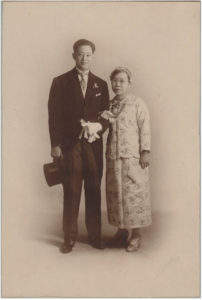07 LEE CHOO NEO 李珠娘
An Extraordinary Life of a Straits-born Woman of the 20th Century
DR LEE CHOO NEO (李珠娘)1895 – 1947 Place of Ancestry: Tong’an 同安
Lee Choo Neo established her child and maternity clinic at 74-3 Bras Basah Road in the 1930s. The three-storey shophouse was also home to her family. She was married to Teo Kim Leng, a director with an auto company, in September, 1922, and they adopted a son and two daughters. When war broke out, the city came under continuous strafing by Japanese planes and Lee tended to the injured.
One day soon after the British surrender, a Japanese officer paid her clinic a visit. She knew him immediately as Nachang Tsutada, one of the sons of her neighbour K. Tsutada, who ran a dental clinic. The children of both families had played together. But the Tsutadas left for Japan when war was imminent. During the war, Nachang then returned as a Lieutenant, and his presence meant certain protection and Lee was granted special permission to drive her car freely, which was a boon to her patients. Members of Lee’s extended family whose homes had been bombed were able to find temporary shelter in her Bras Basah home.
Lee was born into privilege. Her father Lee Hoon Leong was English educated and a trusted managing director in the shipping company owned by the sugar tycoon of Java, Oei Tiong Ham. In her father, Lee found a champion for her education at a time when education for girls was frowned upon. So proud was her father of her academic achievements that he gifted her a Rolls Royce, albeit a second hand one, when she graduated from medical school.
Lee had always excelled in her studies first at the Singapore Chinese Girls School and then at Raffles Girls School, where she was the first Chinese girl to obtain a Senior Cambridge Certificate in 1911. She was also an accomplished and published writer. Her essay on “The Chinese Girl in Singapore”, written when she was just 18, was published by the British magazine called Queen. It has been described as a diatribe on the life of a Chinese girl resigned to a cloistered life of domesticity and fated to wed in an arranged marriage of convenience. In Lee’s words, the life of a Straits-born Chinese girl was “a quiet and uneventful one devoid of all amusements and reactions”.
Lee was to choose for herself a very different trajectory for her life. She was educated, chose her own husband, had a professional career and was a working mother. In a photo dated 1922, Lee, pictured seated, exuded confidence and composure in simple elegance as she posed with all her male colleagues at the Singapore General Hospital, where she had been appointed Lady Assistant Surgeon upon graduation. Outside of her professional and family life, she enjoyed the outdoors playing tennis, and was an enthusiastic photographer, snapping intimate moments with her friends, but also landmark events such as the 1919 centenary celebrations. She painted in oils and played the piano and violin to relax. As a founder member of the Chinese Ladies’ Association (later renamed Chinese Women’s Association or CWA), she was in the company of like-minded women – privileged, but with a heightened awareness of lifting women in universal emancipation. The CWA promoted the physical and social education of Chinese women, as well as ran a rescue home for those at risk.
In 1925, Lee was one of three women appointed to a committee investigating the need for new laws to govern Chinese marriage and divorce. The findings of the committee were a prelude to the passing in 1961 of the Women’s Charter that made polygamy illegal.
Lee’s life is an exemplar of what women could achieve when given equal rights and protection. She was inducted by the Singapore Women’s Association into The Singapore Women’s Hall of Fame in 2014.
Lee died on her 53rd birthday, on 7 September 1947, after a short illness. She was buried on the same day in Bukit Brown. In the traditional Chinese practice of married women following their husbands’ ancestry, her ancestry was listed on her tomb as Tong’an, even though she was born in Singapore and her family was Hakka.
Just across from her ’is the grave of her mother Mak Hup Sin. Her father Lee Hoon Leong is also buried elsewhere in Bukit Brown. Lee Hoon Leong is also the grandfather of Singapore’s first Prime Minister, Lee Kuan Yew.
by Catherine Lim and Lee Chyen Yee
Further Readings
https://mymindisrojak.blogspot.com/2012/01/dr-lee-choo-neo-bukit-brown.
https://tombs.bukitbrown.org/2020/04/lee-choo-neo.html
https://artsandculture.google.com/story/great-peranakans-fifty-remarkable-lives-national-heritage-board-singapore/dgUxkwWru8O2KA?hl=en
Chinese Women’s Association, 100 Fabulous Years, First Edition (2015)


Recent Comments